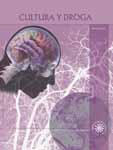Autores/as
Resumen
La ketamina es un anestésico disociativo que se está volviendo muy popular entre los jóvenes que usan drogas. Estudios recientes indican la presencia de poblaciones escondidas de jóvenes que se inyectan esta sustancia en Nueva York y otras ciudades de los Estados Unidos. Aplicando una aproximación étnico-epidemiológica, los autores reclutaron 40 jóvenes que usan drogas inyectadas (menores de 25 años) en New York para explorar los riesgos asociados con el uso de esta sustancia. Este análisis observa los patrones variables y las frecuencias de la inyección examinando aspectos personales, sociales y culturales de las vidas de estos jóvenes. Hemos aprendido que las historias de los consumidores, las dimensiones experimentales, las características socioculturales y las asociaciones con otros jóvenes han ayudado a compilar los diferentes patrones de la inyección de ketamina entre la muestra. En particular, estos descubrimientos indican que los jóvenes que más frecuentemente se han inyectado con esta sustancia siguen las siguientes características: se iniciaron en el uso de la drogas con ketamina, disfrutan los efectos de esta, tenían residencia estable, vivan en los alrededores de la cuidad de Nueva York y se asociaban con otras personas que también se inyectaban la ketamina.
Palabras clave
Citas
Armitage EA, Wetmore LA, Chan DL, Lindsey JC. Evaluation of compliance among nursing staff in administration of prescribed analgesic drugs to critically ill dogs and cats. Journal of American Veterinarian Medical Association 2005;227 (3):425-29.
Becker HS. History, culture and subjective experience: An exploration of the social bases of drug-induced experiences. Journal of Health and Social Behavior 1967;8(3):163-76. [PubMed: 6073200].
Becker, HS. Outsiders:Studies in the Sociology of Deviance. New York: Free Press; 1963.
Becker HS. Becoming a marihuana user. American Journal of Sociology 1953; 59(3): 235-42. Lankenau and Sanders Page 9. J Psychoactive Drugs. Author manuscript; available in PMC 2007 July 19.
Bergman SA. Ketamine: Review of its pharmacology and its use in pediatric anesthesia. Anesthesia Progress 1999;46:10-20. [PubMed: 10551055].
Biernacki P, Waldorf D. Snowball sampling: Problems and techniques of chain referral sampling. Sociological Methods & Research 1981;10(2):141-63.
Carlson RG, McCaughan JA, Falck RS, Wang J, Siegal HA, Daniulaityte R. Perceived adverse consequences associated with MDMA/Ecstasy use among young polydrug users in Ohio: Implications for intervention. International Journal of Drug Policy 2004;15:265-74.
Carnwath, T.; Smith, I. Heroin Century. London: Routledge; 2002.
Clatts M, Welle D, Goldsamt LA. Reconceptualizing the interaction of drug and sexual risk among MSM speed users: Notes toward an ethno-epidemiology. AIDS and Behavior 2001;5(2):115-29.ç
Clatts M, Welle D, Goldsamt L, Lankenau S. An ethno-epidemiological model for the study of trends in illicit drug use: Reflections on the “emergence” of crack injection. International Journal of Drug Policy 2002;13:285-95.
Cloward, R.; Ohlin, L. Delinquency and Opportunity: A Theory of Delinquent Gangs. London: Collier-Macmillan; 1960.
Community Epidemiology Working Group (CEWG). NIH Publication No. 05-5364A. Bethesda, MD: National institute of Health, Division of Epidemiology and Prevention Research, National Institute of Drug Abuse; 2005. Epidemiologic Trends in Drug Abuse. Volume 1: Highlights and Executive Summary.
Copeland J, Dillon P. The health and psycho-social consequences of ketamine use. International Journal of Drug Policy 2005;16:522-31.
Cooley, CH. Human Nature and Social Order. Revised. New York: Schocken Books; 1964.
Corssen G, Domino EF. Dissociative anesthesia: Further pharmacologic studies and first clinical experience with the phencyclidine derivative CI-581. Anesthesia and Analgesia Current Researches 1966;45(1):191-99.
Crofts N, Louie R, Rosenthal D, Jolley D. The first hit: Circumstances surrounding initiation into injecting. Addiction 1996;91(8):1187-96. [PubMed: 8828246].
Curran V, Morgan C. Cognitive, dissociative and psychotogenic effects of ketamine in recreational users on the night of drug use and 3 days later. Addiction 2000;95(4):575-90. [PubMed: 10829333].
Des Jarlais DC, Friedman SR, Perlis T, Chapman TF, Sotheran JL, Paone D, Monterroso E, Neaigus A. Risk behavior and HIV infection among new injectors in the era of AIDS in New York City. Journal of Acquired Immune Deficiency Syndrome and Human Retrovirology 1999;20(1):67-72.
Dorn N, South N. Drug markets and law enforcement. British Journal of Criminology 1990;30(2):171-88.
Faupel, CE. Shooting Dope: Career Patterns of Hard Core Heroin Users. Gainesville, FL: University of Florida Press; 1991.
Finestone H. Cats, kicks and color. Social Problems 1957;5:3-13.
Forsyth AJM, Barnard M, McKeganey NP. Musical preference as an indicator of adolescent drug use. Addiction 1997;92 (10):1317-25. [PubMed: 9489048].
Fuller C, Vlahov D, Arria A, Ompad D, Garfein R, Strathdee S. Factors associated with adolescent initiation of injection drug use. Public Health Reports 2001;116(Suppl 1):13645. [PubMed: 11889281].
Gottfredson, M.; Hirschi, T. A General Theory of Crime. Stanford, CA: Stanford University Press; 1990.
Jansen, K. Ketamine: Dreams and Realities. Sarasota, FL: MAPS; 2001.
Johnson, BD.; Goldstein, PJ.; Preble, E.; Schmeidler, J.; Lipton, DS.; Spunt, B.; Miller, T. Taking Care of Business: The Economics of Crime by Heroin Abusers. Lexington, MA: Lexington Books; 1985.
Kandel DB. Stages in adolescent involvement in drug use. Science 1975;190:912-14. [PubMed: 1188374].
Kandel DB, Yamaguchi K, Chen K. Stages of progression in drug involvement from adolescence to adulthood; Further evidence for the gateway theory. Journal of Studies art Alcohol 1992;53:447-57.
Klein, M. The American Street Gang: Its Nature, Prevalence and Control. New York: Oxford University Press; 1995.
Klein, M. Street Gangs and Street Workers. Englewood Cliff, NJ: Prentice Hall; 1971. Lankenau and Sanders Page 10. J Psychoactive Drugs. Author manuscript; available in PMC 2007 July 19.

 PDF
PDF
 FLIP
FLIP

















